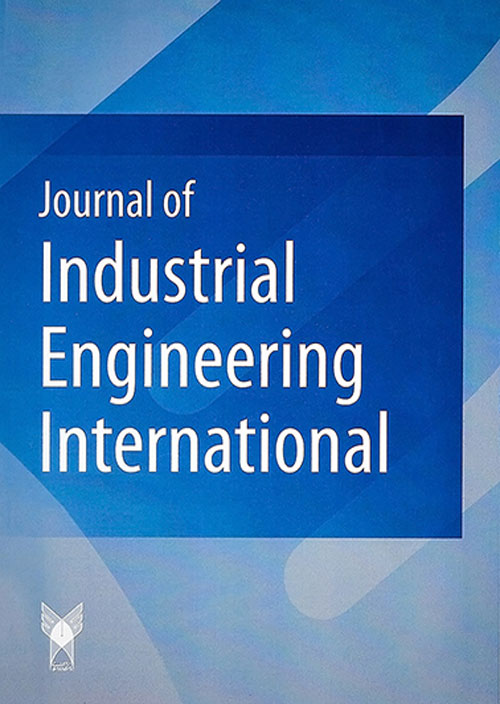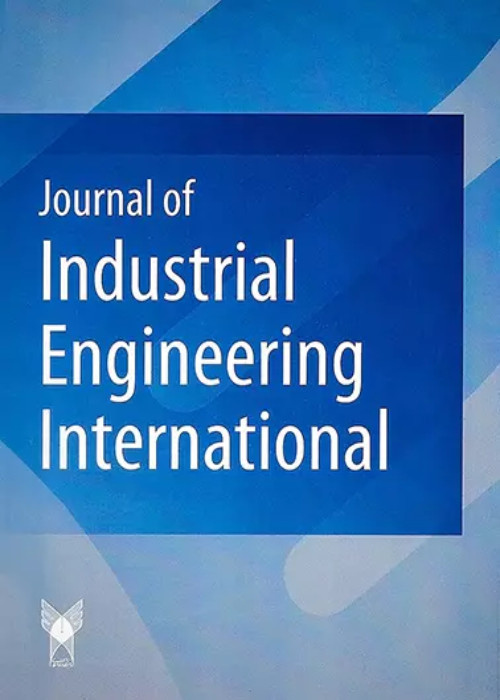فهرست مطالب

Journal Of Industrial Engineering International
Volume:17 Issue: 1, Winter 2021
- تاریخ انتشار: 1400/08/06
- تعداد عناوین: 8
-
-
Pages 1-13This work presents a quantitative approach on the basis of Dynamic Bayesian Network to model and evaluate the maintenance of multi-state degraded systems and their functional dependencies. The reliability and the availability of system are evaluated taking into account the impact of maintenance repair strategies (perfect repair, imperfect repair and under condition-based maintenance (CBM)). According to transition relationships between the states modeled by the Markov process, a DBN model is established. Using the proposed approach, a DBN model for a separator Z1s system of Sour El-Ghozlane cement plant in Algeria is built and their performances are evaluated. Through the result of diagnostic, for improving the performances of separator, the components E, R and F should given more attention and the results of prediction evaluation show that in comparing with perfect repair strategy, the imperfect repair strategy cannot degrade the performances of separator, whereas the CBM strategy can improve the performances considerably. These results show the utility of this approach and its use in the context of a predictive evaluation process, which allows to offer the opportunity to evaluate the impact of the decisions made on the future performances measurement. In addition, the maintenance managers can optimize and improve maintenance decisions continuously.Keywords: Availability, reliability, Dynamic Bayesian Network, Performance Evaluation, Maintenance optimization
-
Pages 14-31
Process capability indices play a vital role in evaluating the conformity of the process properties to the required specifications. Process incapability indices are created by transformation in the process capability indices, leading to the separation of information related to the process accuracy and precision. This separation of information can be very beneficial to specify whether the process is capable or not and to detect deviations in the production processes that produce high-tech products, such as the electronics industry. The main goal of this study is to propose a process incapability index by considering the measurement error for processes with multivariate quality characteristics. The efficiency of this index is then examined by a numerical example using Monte Carlo simulation method. Moreover, the performance of proposed approach is compared with the case where there is no measurement error. In addition, as a practical example, this index is compared with a number of recently proposed indices in the literature, and sensitivity analysis is conducted, as well. The simulation results showed that the measurement error has a significant effect on process capability and incapability indices. Therefore, we strongly suggest that the measurement error has to be considered in the process analysis.
Keywords: Multivariate process incapability index, Measurement errors, Multivariate Normal Distribution, High technology manufacturing processes -
Pages 32-41
The purpose of the current research is to present a location-routing-inventory model for perishable products. The presented model is applied in a two-stage structure. The first-stage decisions confirm the establishment of distribution centers, whereas the second-stage decisions determine the other variables of the problem. For a better management of inventory, it has been used under the names of fresher first and older first policies. In the fresher first policy, the fresher items have a priority to be sent to the customer, whereas in the older first policy, the items with a longer age have the priority to be sent to the customer. The summary of the results of the models demonstrates that among the free, fresher first, and older first policies, it is the free policy that offers a higher profit function to the customer than the other two policies since it is more flexible and general,and encompasses these two extremes. The free policy lets the model determine which items to sell at any given time period in order to maximize profit.Moreover, in the older first policy, since the older items reach the customers sooner than the other items, the number of the expired items is reduced. However, this policy brings the lowest revenue to the customer. In the fresher first policy, since the fresher items are sold first and then the older items are sold, the number of the expired items is increased along the customer horizon. Nevertheless, the customer obtains more revenue compared with the older first policy.
Keywords: Inventory locating, perishable items, Inventory management policy, routing -
Pages 42-51
Risk assessment is an important factor in project cost management. This study addresses the risks associated with a 900 meter long bridge construction project. The risk of a bridge construction project is assessed to limit and quantify the impact on the project. The impact of various risks was investigated to express the impact on the total project contract value at the estimation stage. A project risk analysis is introduced to assess the percentage of risk attributed to the total cost. After assessing the impact of risks on cost using Expected Monetary Value (EMV), a new approach of including uncertainties on risk analyses, using description (C, Q, K), is discussed and its advantages and shortcomings are highlighted. Risk is then assessed at several stages of project execution during the budgeting phase, and risk-based project value (RPV) is used to assess the value of the project at each stage. RPV usually increases as the project progresses towards its goals. Due to this property, the RPV of the entire project can be categorized into the contribution value (CV) of each activity. The CV of an activity is defined as the increase in RPV after each activity completes successfully. The results highlight the positive impact of successfully completing the activities associated with the highest risk. In addition, practical solutions for risk assessment and analysis of bridge construction projects are provided for use by bridge construction contractors, project managers and project management engineers.
Keywords: Expected monetary value (EMV), uncertainty (C, Q, K) description, contribution value (CV) -
Pages 52-62Today, with the development of Information Technology (IT) and economic globalization, the suppliers’ selection has been emphasized in supply chain systems. Accordingly, artificial intelligence-based methods have attracted much attention. Hence, in this research, the selection of appropriate suppliers with respect to the multi-resource supply policy, and the implementation of lateral transshipment have been studied, and meta-heuristic algorithms have been employed to solve the problem. In the proposed method, the supply chain network is improved by minimizing the inventory shortages through utilizing lateral transshipment between different factories. In order to efficiently solve the problem, a hybrid meta-heuristic algorithm based on population-based genetic algorithm (GA) and single-solution simulated annealing (SA), named GASA, is propose, in order to simultaneously gain with the advantages of both algorithms, i.e., global search ability of GA and local search ability of SA. In order to compare the results of the proposed GASA, it is compared with GA and SA, to find the best solution. Given the parameters optimization and conducted analyses and comparisons of primary and hybrid algorithms performance, the hybrid GASA algorithm has been identified as the most efficient algorithm to solve the problem,compared to the other algorithms, emphasizing cost reduction and shortage volume.Keywords: supply chain management, Multi-resource supplier selection, Lateral transshipment, Genetic Algorithm, Simulated Annealing
-
Pages 63-77A truly renewable energy source, solar energy is considered within the context of climate change by various countries among which China, USA, and Germany rely more on solar power. Since there are rare studies regarding how energy drives secure access to sustainability, this study explores the role of solar energy generation in economic, social, and environmental sustainability and energy security in Iran as the main purpose. Using a system dynamics computer simulation model, this paper defines factors affecting the system including four sub-models such as energy and three aspects of sustainability. Besides, energy security is defined as the availability of adequate energy supply to satisfy existing demand. After determining a causal loop diagram, dynamic models, specific trends, and validation and simulation of the system, separate policies are presented along with a combined policy for system improvement. The policies include enhancing foreign investment, increasing tariffs of non-renewable energies, and decreasing energy intensity. This study further reviews relevant policies set forth in the USA, Germany, and China. According to the results, improvement policies are coming to an end. The main contributions are the insights into the sector to support policy-makers and finally, proposing policies for the system improvement.Keywords: Solar energy industry, Sustainability, energy Security, System Dynamics, Policy Making
-
Pages 78-87
Lots of information about customers are stored in the databases of banks. These databases can be used to assess the credit risk. Feature selection is a well-known concept to reduce the dimension of such databases. In this paper, a multi-stage feature selection approach is proposed to reduce the dimension of database of an Iranian bank including 50 features. The first stage of this paper is devoted to removal of correlated features. The second stage of it is allocated to select the important features with genetic algorithm. The third stage is proposed to weight the variables using different filtering methods. The fourth stage selects feature through clustering algorithm. Finally, selected features are entered into the K-nearest neighbor (K-NN) and Decision Tree (DT) classification algorithms. The aim of the paper is to predict the likelihood of risk for each customer based on effective and optimum subset of features available from the customers.
Keywords: Clustering, Credit risk prediction, filtering method, Genetic Algorithm, Hybrid feature selection -
Pages 88-97Profile monitoring is one of the new statistical quality control methods used to evaluate the functional relationship between the descriptive and response variables to measure the process quality. Most of the studies in this field concern processes whose response variables follow the normal distribution function, but in many industries and services, this assumption is not true. The presence of outliers in the historical data set could have a deleterious effect on phase I parameter estimation. Therefore, in this paper, we propose a robust cluster-based method for estimating the parameters of generalized linear profiles in phase I. In this method, the effect of data contamination on estimating the generalized linear model parameters is reduced and as a result, the performance of T^2 control charts is improved. The performance of this method has been evaluated for two specific modes of generalized linear profiles, including logistic and Poisson profiles, based on a step shift. The simulation results indicate the superiority of this cluster-based method in comparison to the non-clustering method and provide a more accurate estimation of the parameters.Keywords: Generalized linear models, Phase I, Hotelling T^2, Clustering, robust


